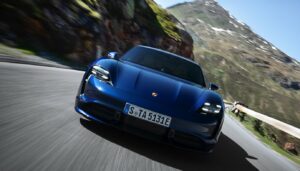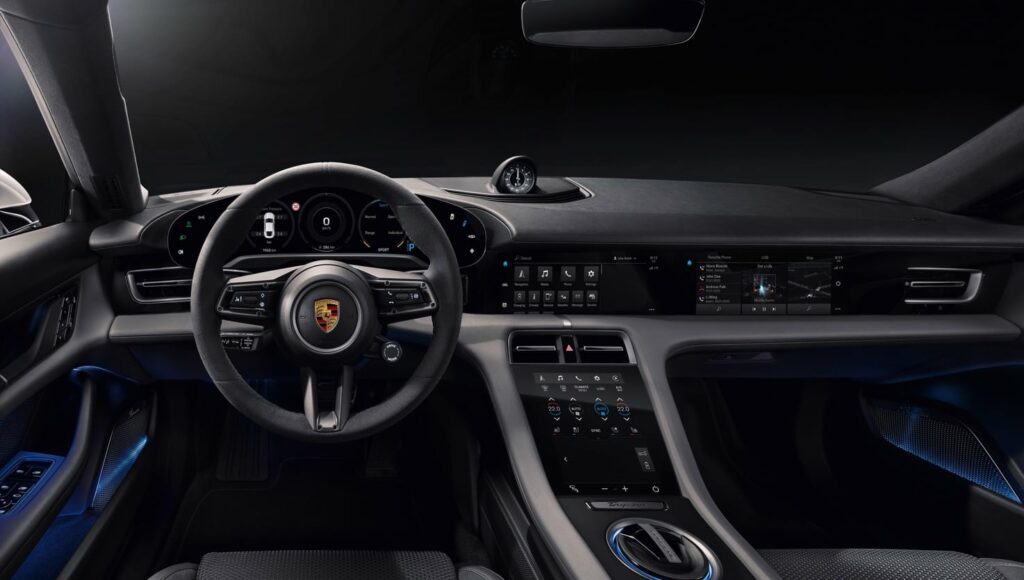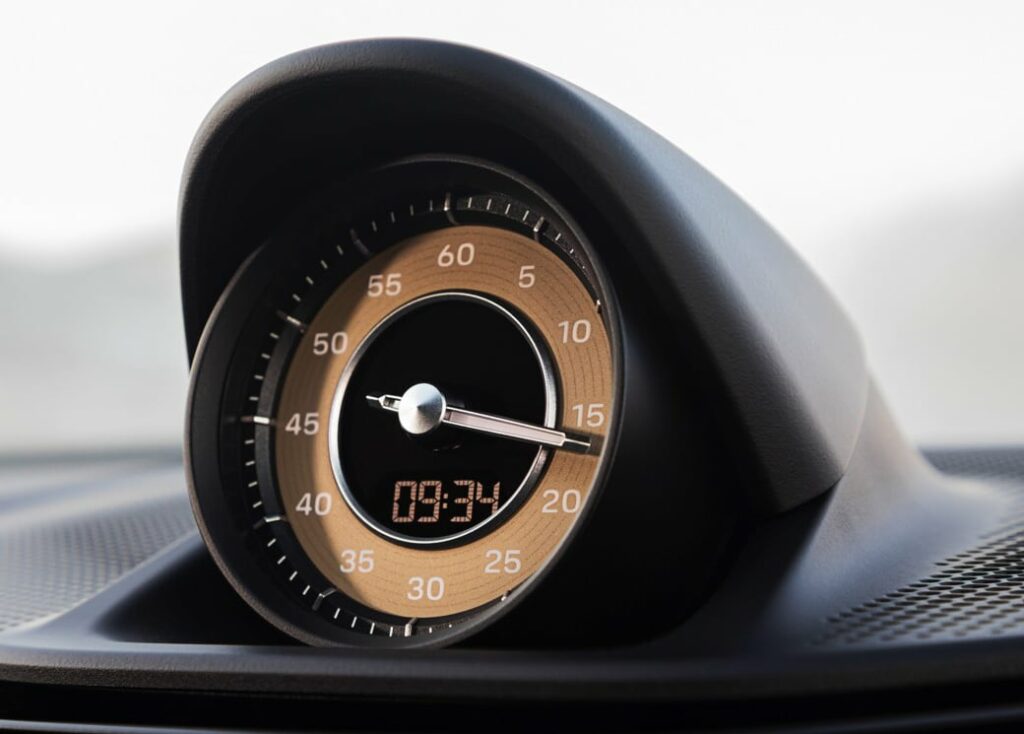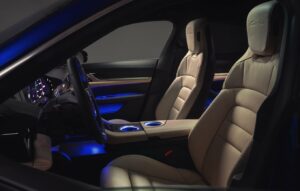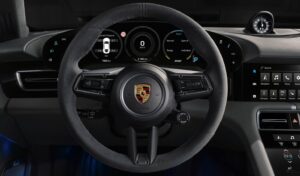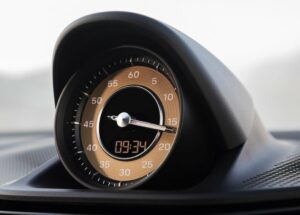Porsche Taycan 4S Plus
The Porsche Taycan 4S Plus is not officially named. However, Porsche offers a number of options and packages that can be added to the Taycan 4S to improve its performance and features.

For example, Porsche offers the optional Performance Battery Plus, which increases the Taycan 4S’s battery capacity from 79.2 kWh to 93.4 kWh, providing more range and more power. Performance Battery Plus also includes a more powerful onboard charger capable of handling up to 11 kWh of AC power.

In addition, Porsche offers several performance-oriented packages for the Taycan 4S, such as the Sport Chrono package, which adds performance-enhancing features such as launch control and Sport Plus driving mode. The car may also be equipped with Porsche Active Suspension Management (PASM), which provides adaptive suspension damping and suspension height adjustment for a more customizable driving experience.
Perhaps some dealers or owners may refer to the Taycan 4S with these additional options as “4S Plus” or “4S with Performance Battery Plus,” but Porsche does not officially use these designations.
| Performance | |
| Acceleration 0 – 100 km/h | 4.0 sec |
| Top Speed | 250 km/h |
| Electric Range | 435 km |
| Total Power | 420 kW (571 PS) |
| Total Torque | 650 Nm |
| Drive | AWD |
| Battery and Charging | |
| Battery Capacity | 93.4 kWh |
| Battery Useable | 83.7 kWh |
| Europe | |
| Charge Port | Type 2 |
| Port Location | Right Side – Front |
| Port Location 2 | Left Side – Front |
| Charge Power | 11 kW AC |
| Charge Time (0->435 km) | 9 hours |
| Charge Speed | 49 km/h |
| Fastcharge Port | CCS |
| FC Port Location | Right Side – Front |
| FC Port Location 2 | – |
| Fastcharge Power (max) | 262 kW DC |
| Fastcharge Time (44->348 km) | 19 min |
| Fastcharge Speed | 960 km/h |
| Energy Consumption | |
| EVDB Real Range | |
| Range | 435 km |
| Vehicle Consumption | 192 Wh/km |
| CO2 Emissions | 0 g/km |
| Vehicle Fuel Equivalent | 2.2 l/100km |
| WLTP Ratings (TEL) | |
| Range | 464 km |
| Rated Consumption | 219 Wh/km |
| Vehicle Consumption | 180 Wh/km |
| CO2 Emissions | 0 g/km |
| Rated Fuel Equivalent | 2.5 l/100km |
| Vehicle Fuel Equivalent | 2.0 l/100km |
| WLTP Ratings (TEH) | |
| Range | 389 km |
| Rated Consumption | 260 Wh/km |
| Vehicle Consumption | 215 Wh/km |
| CO2 Emissions | 0 g/km |
| Rated Fuel Equivalent | 2.9 l/100km |
| Vehicle Fuel Equivalent | 2.4 l/100km |
| TEL = Test Energy Low | TEH = Test Energy High | |
|
Rated = official figures as published by manufacturer. Rated consumption and fuel equivalency figures include charging losses.
|
|
|
Vehicle = calculated battery energy consumption used by the vehicle for propulsion and on-board systems.
|
|
| Real Energy Consumption between 138 – 262 Wh/km | |
| City – Cold Weather | 202 Wh/km |
| Highway – Cold Weather | 262 Wh/km |
| Combined – Cold Weather | 229 Wh/km |
| City – Mild Weather | 138 Wh/km |
| Highway – Mild Weather | 204 Wh/km |
| Combined – Mild Weather | 169 Wh/km |
| Energy use for each trip will vary considerably depending on the driver and the conditions. Therefore, we have provided a range of estimates which can be useful in developing an understanding of the potential benefits of this technology. | |
| Safety (Euro NCAP) | |
| Adult Occupant | 85% |
| Child Occupant | 83% |
| Rating Year | 2019 |
| Vulnerable Road Users | 70% |
| Safety Assist | 73% |
| Dimensions and Weight | |
| Length | 4963 mm |
| Width | 1966 mm |
| Width with mirrors | 2144 mm |
| Height | 1379 mm |
| Wheelbase | 2900 mm |
| Weight Unladen (EU) | 2295 kg |
| Gross Vehicle Weight (GVWR) | 2880 kg |
| Max. Payload | 660 kg |
| Cargo Volume | 407 L |
| Cargo Volume Max | No Data |
| Cargo Volume Frunk | 84 L |
| Roof Load | 75 kg |
| Tow Hitch Possible | No |
| Towing Weight Unbraked | 0 kg |
| Towing Weight Braked | 0 kg |
| Vertical Load Max | 0 kg |
| Miscellaneous | |
| Seats | 4 people |
| Isofix | Yes, 2 seats |
| Turning Circle | 11.7 m |
| Platform | VW J1 |
| Car Body | Sedan |
| Segment | F – Luxury |
| Roof Rails | No |
| EV Dedicated Platform | Yes |
Home and Destination Charging (0 -> 100%)
A public charging station is required to use the highest possible charging rate. The EVSE/charging station’s charging capacity affects how long it takes to fully charge the battery. The table below shows all possible options for fully charging the Porsche Taycan 4S Plus .
In Europe, plugging an electric car into an outlet is often as easy as plugging it into a household outlet, but there are differences from country to country. The table below shows the different ways to charge the Porsche Taycan 4S Plus , but in some countries some chargers may not be available.
Type 2 ( IEC 62196)

| Charging Point | Max. Power | Power | Time | Rate |
| Standard 11.0 kW On-Board Charger | ||||
| Wall Plug (2.3 kW) | 230V / 1x10A | 2.3 kW | 43 hours | 10 km/h |
| 1-phase 16A (3.7 kW) | 230V / 1x16A | 3.7 kW | 26h45m | 16 km/h |
| 1-phase 32A (7.4 kW) | 230V / 1x32A | 7.4 kW | 13h30m | 32 km/h |
| 3-phase 16A (11 kW) | 400V / 3x16A | 11 kW | 9 hours | 48 km/h |
| 3-phase 32A (22 kW) | 400V / 3x16A | 11 kW | 9 hours | 48 km/h |
| Optional 22.0kW On-Board Charger | ||||
| Wall Plug (2.3 kW) | 230V / 1x10A | 2.3 kW | 43 hours | 10 km/h |
| 1-phase 16A (3.7 kW) | 230V / 1x16A | 3.7 kW | 26h45m | 16 km/h |
| 1-phase 32A (7.4 kW) | 230V / 1x32A | 7.4 kW | 13h30m | 32 km/h |
| 3-phase 16A (11 kW) | 400V / 3x16A | 11 kW | 9 hours | 48 km/h |
| 3-phase 32A (22 kW) | 400V / 3x32A | 22 kW | 4h30m | 97 km/h |
Fast Charging (10 -> 80%)
If you want to enjoy driving an electric car, one of the most important features to consider is the number of miles per hour the car can travel while charged. This is called the “range” of the car. All electric cars have a certain range, even if they are 100% charged. This is because they do not have an internal combustion engine to lean on if you need to drive a long distance.
Max. Power: The maximum power provided by the charging point
Avg. Power: The average power provided by the charging point during a session of 10% to 80%.
Time: the time it takes to charge from 10% to 80%
Speed: the average charging rate during the session of 10% to 80%
Combined Charging System (CCS Combo 2)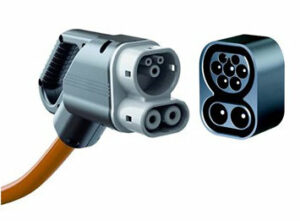
| Charging Point | Max. Power | Avg. Power | Time | Rate |
| CCS (50 kW DC) | 50 kW | 50 kW | 74 min | 240 km/h |
| CCS (175 kW DC) | 166 kW | 157 kW | 24 min | 760 km/h |
| CCS (350 kW DC) | 262 kW | 197 kW | 19 min | 960 km/h |
| Brand | Porsche |
| Model | Taycan 4S Plus |
| Body Style | Sedan |
| Car Engine | electric |
| Motor power | 420 |
| Maximum Torque, Nm | 650 |
| Battery Energy, kWh | 93.4 |
| Power reserve (NEDC/EPA/WLTP), km | - / - / 435 |
| Level Charging (230/400/DC), hours | - / 4.3 / 0.19 |
| Electrical Acceleration, 0-100 km/h (0-62.1 mph) in sec | 4.0 sec |
| Top Speed, km/h | 250 |

















